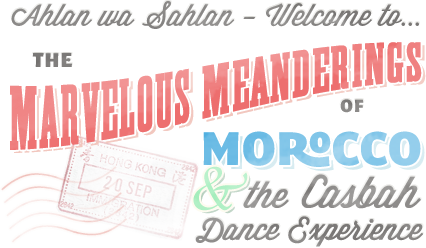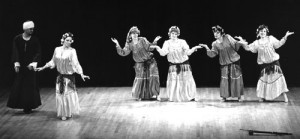Did you know that Morocco & the Casbah Dance Experience is a New York State non-profit organization that can receive Tax-Deductible donations from you?
Since 1978, Morocco has been a self-sustaining non-profit, but is now undertaking a new era of fundraising in order to support the efforts of Morocco and her dance company to recover, preserve, and present the art of ethnic dance forms of North Africa & the Near & Middle East, true to their origins. Our mission is also to maintain a school and dance company to teach and keep these dance traditions alive and to present the positive aspects of these cultures through their dance and music in order to bridge divides and create bonds between cultures.
Morocco believes the importance of her work is the fact that she is one of the few who works diligently for the preservation and presentation of Middle Eastern dance forms that are quickly disappearing from the global artistic landscape. Many writings on these dances are biased with racism, colonialism, and fanatical religious evangelism. For the ignorant, the dances are most often seen as the lowest common denominator of dance; ugly and ungraceful because they have no resemblance to European tradition in ballet and other modern dance techniques. It is our goal to deconstruct these negative views of Middle Eastern dance and present the varied, beautiful, and fascinating authentic ethnic dance forms.
Without our work, many of these traditional, authentic ethnic dances would disappear and a rich cultural dance heritage would be lost. With your support, Morocco & the Casbah Dance Experience will continue to grow and be able to offer more extensive support to the following initiatives for which we are now pursuing funding:
Film Preservation
Between 1977 and 1983, Morocco made many sojourns to Morocco and Egypt to record dances of indigenous performers in order to preserve them for posterity. They are dancers that she had been seeing since her first trip in 1963.
In some places, dancers are now prevented from performing because of religious fundamentalism. In others, economic necessity has led to the break-up of these communal infrastructures. Luckily, Morocco was able to capture these exceptional and breathtaking dances on film. All of the performers in the film footage are either dead or too old to perform anymore; it is the only true record of these virtually forgotten ethnic folk dances.
Without the preservation of this footage, the film will deteriorate and be lost; future educators and dancers will be unable to learn and expand their understanding of these precious cultural legacies of dance. The plan is to transfer the more than 50 hours of Super 8mm Sound Film to Digital Beta. The transfer will also allow Morocco to re-edit her award-winning video series with the color-enhanced film. Madeleine Nichols, former curator of the New York Library for the Performing Arts Dance Division, expressed interest in archiving the tapes for future generations.
New Choreography
With a company of 8 dancers, and countless lectures and performance concerts over the years, Morocco has had little time or the financial support to explore new group choreographies and interpretations of dances for presentations. It is her goal to look at different ways of choreographing Eastern and North African ethnic dances in order to expose the audience and students to dances never before seen by most people.
The Guedra is a ritual dance dance that Morocco has performed solo for many years. It was formerly a group endeavor for the Casbah Dance Experience. She now wants to rework the choreography as a group piece, the way it is meant to be.
The Algerian Medahat is similar to the the Moroccan Schikhatt and is mostly danced by professional female performers for women’s parties before weddings. Like the Schikhatt, the purpose is to show the bride what she’s supposed to do as a wife in a fun and satirical way, and at the same time, sing improvised songs that poke fun at the family and friends. However, the movements and dress are very different.
There is also the Sulukule (Roman) Karsilama, a bluesy re-interpretation of the Turkish 9/8 Karsilama rhythm that Morocco has seen become popular in the Roma (Gypsy) ghetto in Istanbul, and from there into the nighclubs and at wedding performances. Morocco will use this new and different way of approaching the usual technique and music of a Sulukule to create a vibrant and theatrical experience similar to what she witnessed.
With your help, Morocco & the Casbah Dance Experience will have the financial means necessary to explore these new choreographic works, support working dancers, and attain new costumes that are needed.
Research Trips
Far and above, the most valuable training Morocco has received has been her firsthand observation of dance through her many research trips over the years, starting in 1963, to such countries as Morocco, Egypt, Tunisia, Lebanon, Algeria, Turkey, Greece, Jordan, Iran, and Syria. During these trips, she collects all the possible music, steps and styles of dances from many on-site viewings, and questions the dancers to discover as much as possible about a dance. Morocco then chooses a variety of the most typical steps and figures and presents them in choreography true to their origins, while pleasing to the eyes and ears of the theater public.
Funding would allow Morocco to continue these trips in order to recover, preserve, and present ethnic dance forms that have yet to be seen by most audiences.
General Operations
Funding can also be applied towards the day-to-day operations of Morocco & the Casbah Dance Experience, including administrative help, lights and electric, and the many other responsibilities of running an office, studio and non-profit organization.
FOR MORE INFORMATION ABOUT THE INITIATIVES LISTED ABOVE
PLEASE CONTACT MOROCCO
DONATE BY MAIL WITH OUR EASY Donation Form (pdf file).

